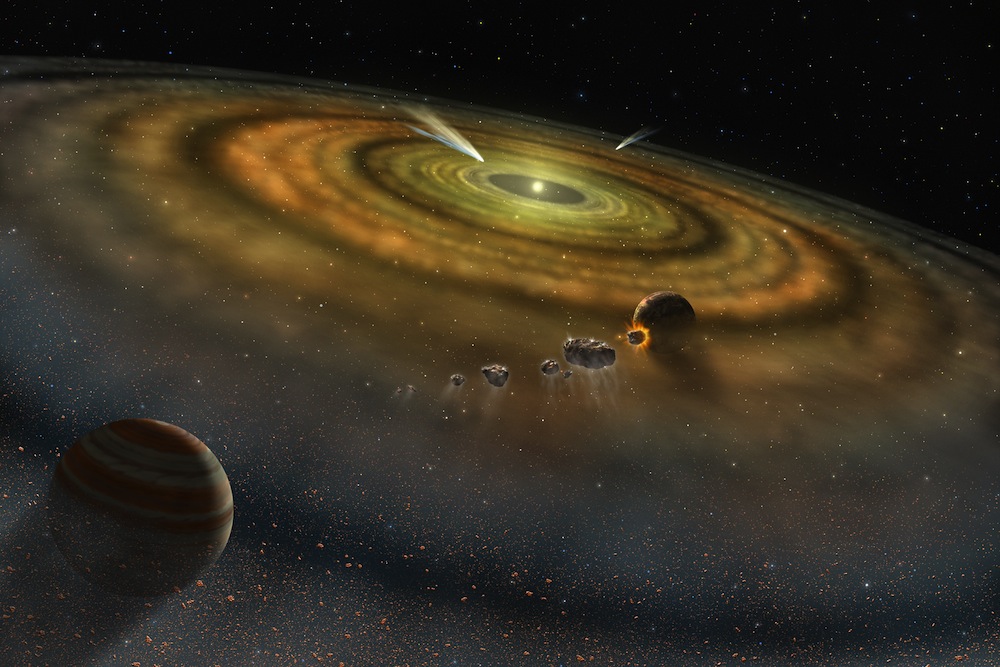New Horizons: 5 Things Pluto Flyby Could Reveal About Planet Earth

Nine and a half years after it launched into space, a NASA probe is set to become the first spacecraft to fly by the dwarf planet Pluto. The New Horizons spacecraft is expected to make its closest approach tomorrow (July 14) at 7:49 a.m. EDT (1149 GMT), coming within 7,800 miles (12,500 kilometers) of Pluto's surface. But even 4.67 billion miles (7.5 billion km) away, the historic mission could help scientists learn more about planet Earth. This is because studying other objects in the solar system can provide clues about Earth's history. Here are five things researchers can learn about Earth by studying the dwarf planet Pluto.
How Earth formed
Earth and the other planets in this solar system were likely born after a bunch of smaller objects smashed into each other. In fact, early in Earth's history, a Mars-sized object nearly annihilated the planet, according to NASA.The resulting pieces of debris eventually coalesced into the moon we see today. [Photo Timeline: How the Earth Formed]
Roughly 4 billion years ago, the inner solar system was a billiard zone, partly because Jupiter's strong gravity served as a slingshot that sent asteroids and comets hurtling toward the sun. In the region of space where Pluto is found, called the Kuiper Belt, icy and rocky objects had a relatively tranquil environment. This means that observing Pluto (and similar objects in the Kuiper Belt) offers hints about what the solar system looked like early in its history.
Where Earth's water came from
Last year, scientists discovered that water from comets may not have seeded Earth with life-building molecules, as had previously been thought. Observations from the European Rosetta spacecraft showed a different type of water on Comet 67P/Churyumov-Gerasimenko. The molecules of water (specifically, the deuterium-to-hydrogen ratio) were different from the molecules found on Earth, according to a study published in the journal Science in December 2014.
There are many objects in the solar system that are icy, including moons, dwarf planets and even parts of the planet Mars. It's possible that there is ice on Pluto as well, scientists have said. Examining the ice on the dwarf planet could help researchers refine theories about how water spread through the solar system.
Get the world’s most fascinating discoveries delivered straight to your inbox.
How life began on Earth
Life on Earth is full of carbon. This is why the potential discovery of organics (carbon-based molecules) in other parts of the solar system is such an exciting prospect. While not every organic chemical originated from something living, they are considered the building blocks of life.
Are there organics even on icy, hostile Pluto? There are some reasons to think there may be, given that organics have been found in similarly life-unfriendly environments such as Mercury and Comet 67P/Churyumov-Gerasimenko. Finding organic material — or even not finding them — could give scientists a better idea of how life first arose on Earth.
Earth's atmospheric structure
Pluto has something of a bizarre atmosphere. The dwarf planet's gravity is so low that its tenuous atmosphere extends much higher than Earth's atmosphere does. Some scientists think the dwarf planet's atmosphere collapses onto the surface when Pluto is colder. Because Pluto's orbit is taking it closer to the sun right now, gases in the atmosphere are heating up and expanding. [5 Strange Facts About Pluto]
By studying the atmospheres of other worlds, astronomers can learn more about how these same processes work on Earth. For example, Venus has a hothouse surface driven by a runaway greenhouse effect. Measurements of Venus' superhot, hellish atmosphere have helped scientists better understand global warming on Earth.
How the sun affects Earth
Life on Earth wouldn't survive for long without the sun. Most of the heat on Earth comes from its closest stellar neighbor. The sun even has effects high in the atmosphere, such as when solar flares belch gas (called coronal mass ejections) toward Earth and "excite" molecules in its atmosphere, causing stunning auroras (also known as the northern and southern lights).
While auroras are benign, the sun's radiation can also zap power lines or satellites during so-called geomagnetic storms. Scientists are interested in seeing how the sun interacts with atmospheres throughout the solar system, including at Pluto. These observations will help researchers better predict the effects of intense solar activity, ranging from what happens after a solar flare to how the sun affects Earth's climate.
Follow Live Science @livescience, Facebook & Google+. Original article on Live Science.

Elizabeth Howell was staff reporter at Space.com between 2022 and 2024 and a regular contributor to Live Science and Space.com between 2012 and 2022. Elizabeth's reporting includes multiple exclusives with the White House, speaking several times with the International Space Station, witnessing five human spaceflight launches on two continents, flying parabolic, working inside a spacesuit, and participating in a simulated Mars mission. Her latest book, "Why Am I Taller?" (ECW Press, 2022) is co-written with astronaut Dave Williams.
 Live Science Plus
Live Science Plus







